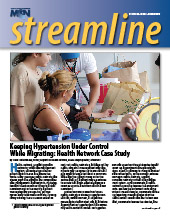
Juana* had been in an abusive relationship for years. For the last two years, she’d been working with the behavioral health clinician at her local community health center in Arkansas. The previous year, as part of a new statewide initiative called Project Catalyst, the health center had partnered closely with a domestic violence agency and shelter, and the clinician had discussed the shelter as an option for the woman during recent visits. After many years in an abusive relationship, the woman was now ready to make the leap. After her appointment, she visited the shelter’s thrift store — a less intimidating entry into the shelter’s space, and a location that the clinician had offered as a place to learn more about her options — and was guided successfully through the process of obtaining a protection order. The clinicians at Juana’s health center had been trained on intimate partner violence (IPV) and the center had partnered with a local shelter as part of Project Catalyst, a project that seeks to improve the health and safety outcomes for survivors of IPV and human trafficking (HT) and to promote prevention by building partnerships between community health centers and domestic violence agencies. A project of Futures Without Violence, a national nonprofit focused on ending IPV, Project Catalyst is supported through a unique collaboration within the US Department of Health and Human Services partners, including the Administration for Children and Families’ Family and Youth Services Bureau, HRSA’s Bureau of Primary Health Care, and HRSA’s Office of Women’s Health. Project Catalyst’s two-part model works locally with health centers while also addressing state- and territory-wide policies around IPV and HT, with the ultimate goal of preventing IPV and HT and increasing access to health and safety supports for survivors.
At the state/territory level, Project Catalyst brings together leadership from throughout the state/territory to promote policy and systems changes that support an integrated and improved response to IPV and HT at community health centers. Through a competitive application process, Project Catalyst identifies states/territories with which to partner. During its first phase, running from 2016 to 2017, Project Catalyst was implemented in four states; last year, they launched their second phase with three more states and a US territory, expanding efforts to include leadership from state/territory Primary Care Associations, Domestic Violence Coalitions, Departments of Public Health, and Departments of Health, to build expertise in those key state and territory leaders.
Locally, staff at each participating community health center receives training and technical assistance on IPV assessment and response from Futures Without Violence based on evidence-based strategies. They also build strong relationships with a local community-based organization focused on IPV, like a shelter or advocacy nonprofit, to improve community connections and assure a warm handoff for patients to access both health and community resources as part of the strategy.
According to Anna Marjavi, the Health Program Director at Futures Without Violence, health centers outside of the states and territories participating in the initiative can still benefit, via the online toolkit. Available at https://ipvhealthpartners.org, the toolkit assists health centers in building a “comprehensive and sustainable response” to IPV and human trafficking. “We direct people to learn the promising practices from the sites that have implemented [Project Catalyst resources]. The site offers actionable tools for people to create their own local partnerships between community health centers and domestic violence programs,” Marjavi said.
The toolkit, which offers five steps for health centers to implement, guides clinicians away from the formerly widespread use of a yes/no screening tool. “What we’ve learned is that people don't always feel comfortable or safe disclosing that information — but we do feel that health care providers are the right people to bring it up,” Marjavi said, noting that fears over immigration status, systems involvement, confidentiality, and privacy, and other concerns, may prevent patients from speaking honestly or directly. The toolkit helps clinicians shift from disclosure-driven practice and to universal education. “You can still ask a pointed question — ‘could something like this be going on for you?’ — but we’re not reliant on getting that ‘yes,’” Marjavi noted.
The intervention is organized around the four steps represented in the acronym “CUES”: confidentiality, universal education and empowerment, and support.
Confidentiality: Patients should be seen one-on-one. “That can be a pretty big systems shift for some clinics,” Marjavi admitted, as many health centers do not have a policy specifying that patients are to be seen alone, but seeing the patient alone for even part of the visit is key. The clinician must also disclose the limits of confidentiality before discussing IPV or HT, Marjavi added.
Universal Education and Empowerment: The toolkit’s simple safety card helps guide the conversation on IPV and HT, and is provided to all patients. Clinicians can cover what constitutes an unhealthy relationship, and the health effects of IPV and HT. Clinicians are encouraged to give patients two safety cards — one for the patient, and one that the patient can give to a friend. “This normalizes the exchange, and it empowers people to be seen as helpers,” Marjavi said.
Support: By offering a referral to the community organizations with which the health center has partnered, clinicians help patients envision the next step, opening a pathway out of their present situation. “The heart of the intervention is the partnership with the community-based organization,” Marjavi maintained. Patients are also given information on 24-hour hotlines and other resources. Clinicians can give language around future support as well, “like how to reach them, or that they can always come back, or ‘I always have an open door,’” Marjavi offered.
The project goes beyond IPV and HT. “At the state/territory-wide level, we’re thinking about opportunities for state/territory policy change, thinking of ways to embed it and sustain it in the long run in the state or territory [that is engaged in the initiative],” Marjavi noted. In the exam room, clinicians are connecting the dots between IPV, HT, and overall health: “Can the patient even pick up a prescription? [The patient] is in a smoking cessation program, but is she going to let go of smoking, given the other things going on in life?... IPV and trafficking are so connected to a whole host of health issues, and to social determinants of health, so we want programs thinking about and incorporating partnerships” around issues outside of IPV and trafficking as well, Marjavi said.
* Patient’s name and locations have been changed to protect patient identity.
Resources
Access the toolkit and the five-step implementation program for health centers at: https://ipvhealthpartners.org/
Learn more about the issue and their approach at: https://ipvhealth.org/
Futures Without Violence has developed several versions of the safety card:
- Reproductive Health Safety Card (in English and Spanish): https://bit.ly/2JrpZ1A
- Adolescent Health Safety Card (in English and Spanish): https://bit.ly/2PSCZ1s
- General Health Safety Card (in English, Spanish, Chinese, or Tagalog): https://bit.ly/2JjTWSr
Learn more about Project Catalyst at: Project Catalyst web page: https://www.futureswithoutviolence.org/health/project-catalyst/
Additional resources from Futures Without Violence are available at: https://www.futureswithoutviolence.org/health
Read this article in the Summer 2019 issue of Streamline here!
Sign up for our eNewsletter to receive bimonthly news from MCN, including announcements of the next Streamline.
